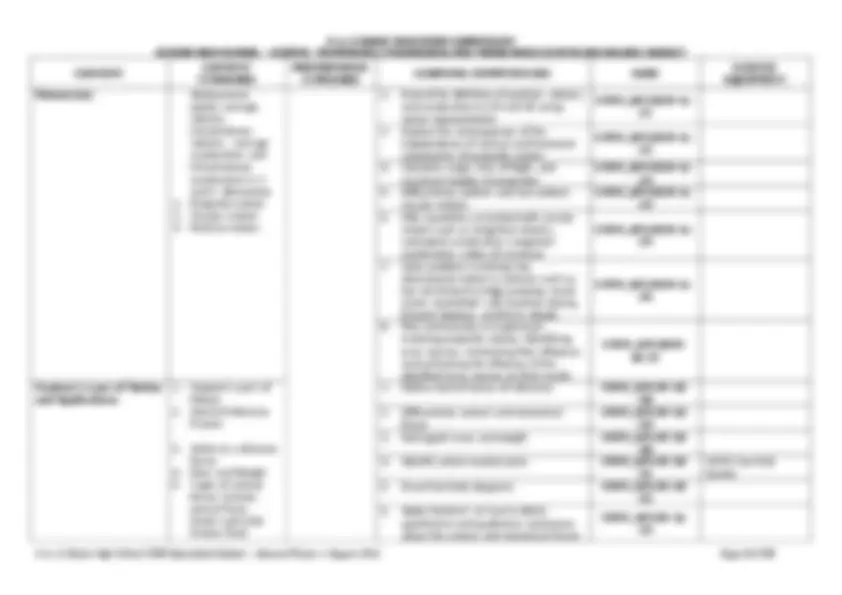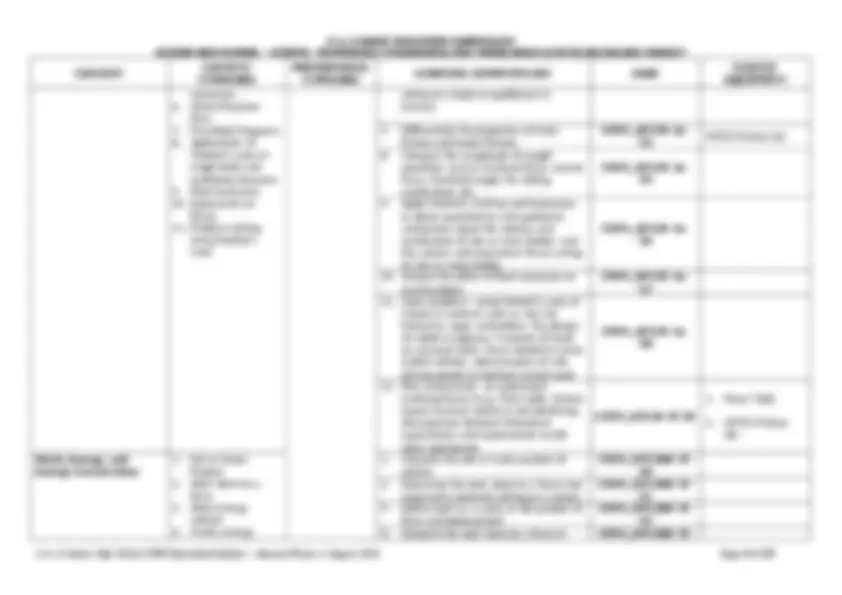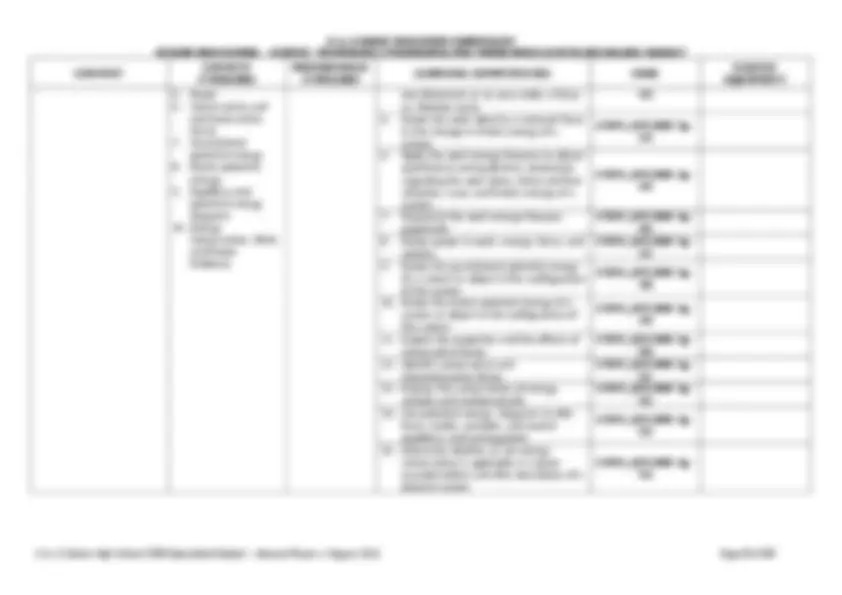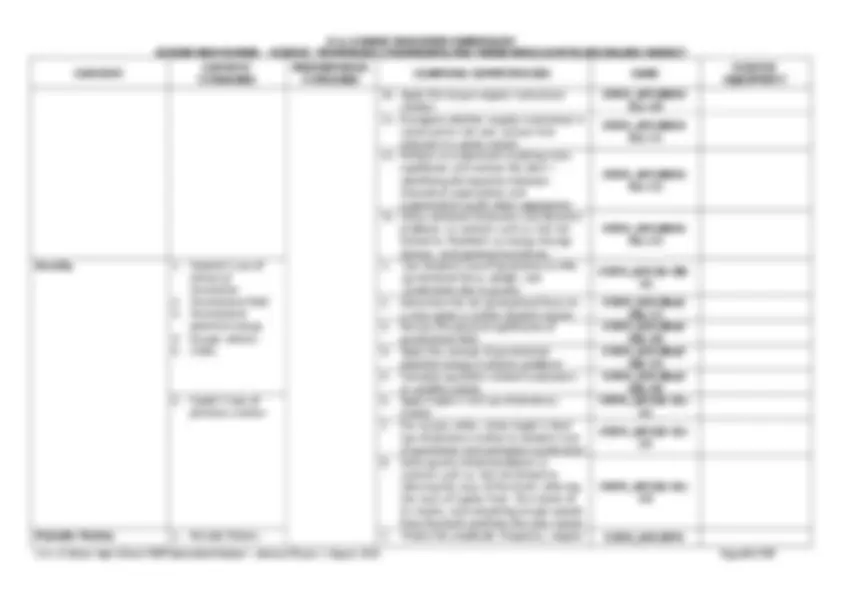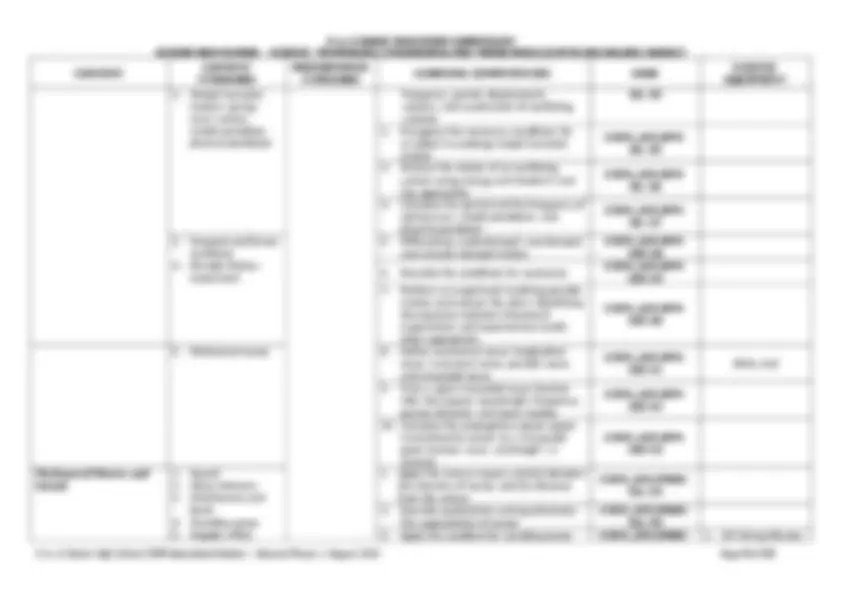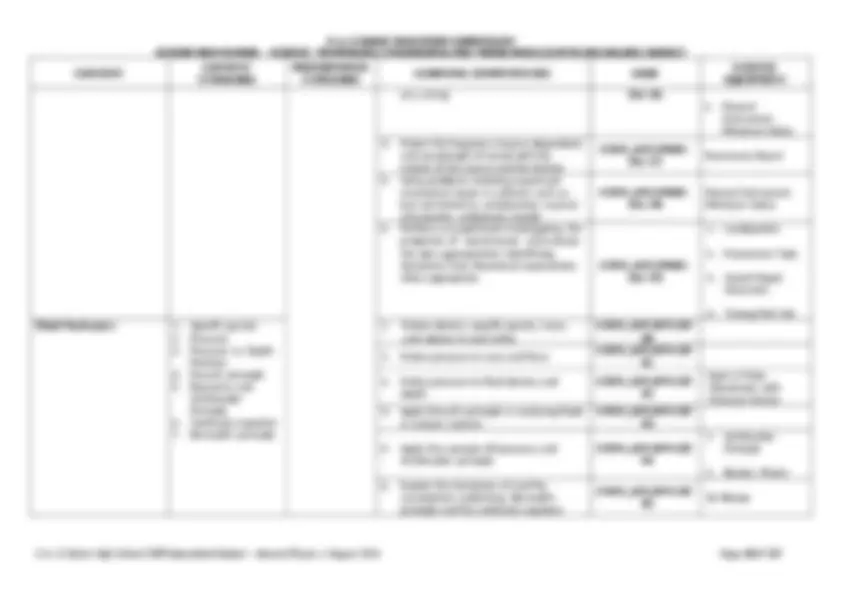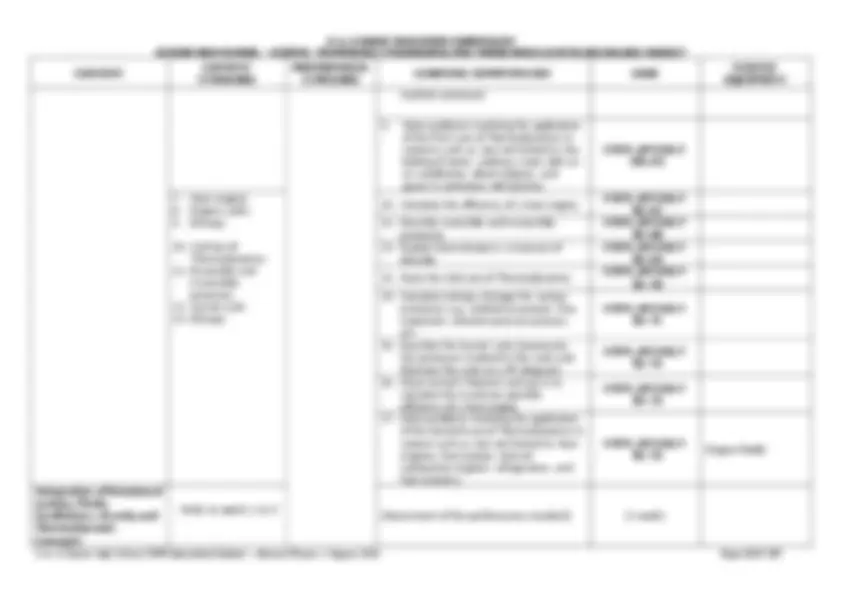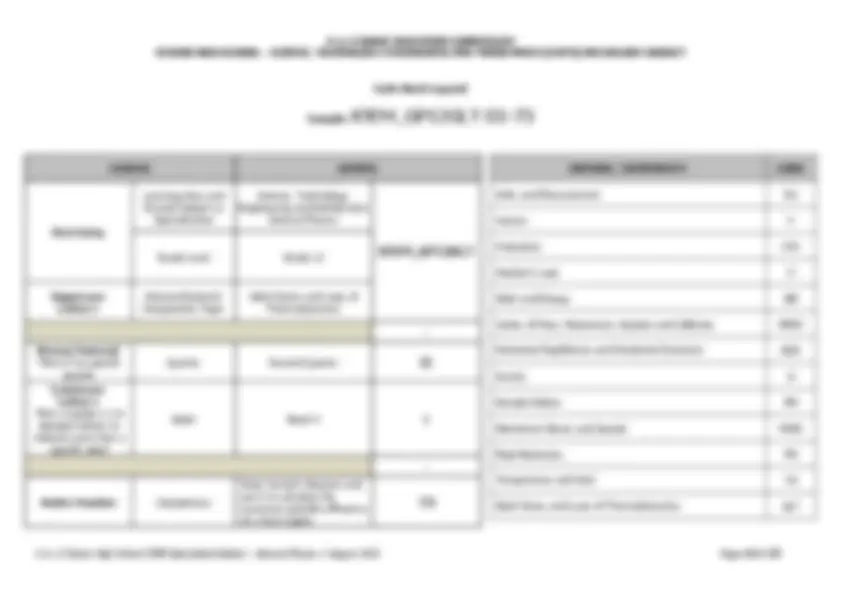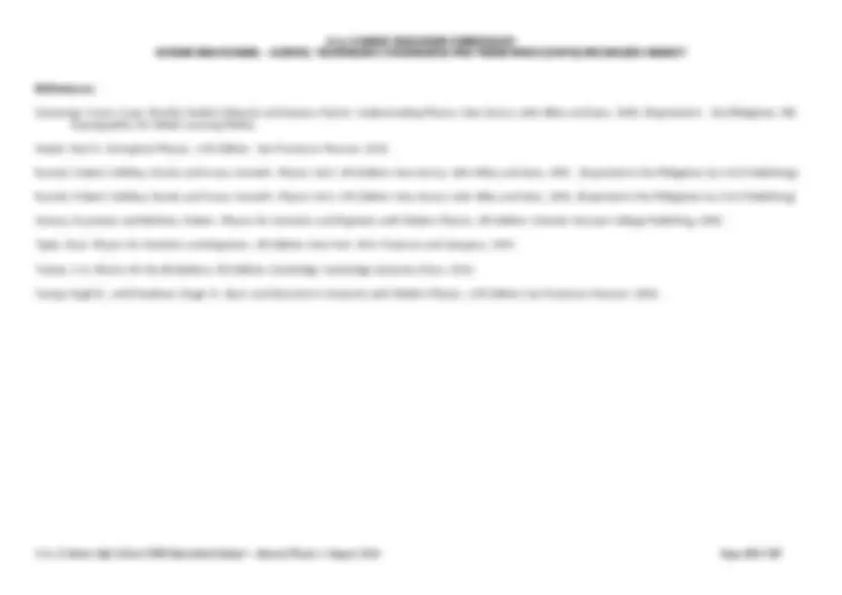Download "The introduction of Physics" and more Exercises Physics in PDF only on Docsity!
SENIOR HIGH SCHOOL – SCIENCE, TECHNOLOGY, ENGINEERING AND MATHEMATICS (STEM) SPECIALIZED SUBJECT
Grade: 12 Quarters: General Physics 1 (Q1&Q2) Subject Title : General Physics 1 No. of Hours/ Quarters: 40 hours/ quarter Prerequisite: Basic Calculus
Subject Description: Mechanics of particles, rigid bodies, and fluids; waves; and heat and thermodynamics using the methods and concepts of algebra, geometry, trigonometry, graphical analysis, and basic calculus
CONTENT
CONTENT
STANDARD
PERFORMANCE
STANDARD
LEARNING COMPETENCIES CODE
SCIENCE
EQUIPMENT
- Units
- Physical Quantities
- Measurement
- Graphical Presentation
- Linear Fitting of Data
The learners demonstrate an understanding of...
- The effect of instruments on measurements
- Uncertainties and deviations in measurement
- Sources and types of error
- Accuracy versus precision
- Uncertainty of derived quantities
- Error bars
- Graphical analysis: linear fitting and transformation of functional dependence to linear form
The learners are able to...
Solve, using experimental and theoretical approaches, multiconcept, rich-context problems involving measurement, vectors, motions in 1D, 2D, and 3D, Newton’s Laws, work, energy, center of mass, momentum, impulse, and collisions
The learners...
- Solve measurement problems involving conversion of units, expression of measurements in scientific notation
STEM_GP12EU-Ia- 1
- Differentiate accuracy from precision
STEM_GP12EU-Ia- 2
- Differentiate random errors from systematic errors
STEM_GP12EU-Ia- 3
- Use the least count concept to estimate errors associated with single measurements
STEM_GP12EU-Ia- 4
- Estimate errors from multiple measurements of a physical quantity using variance
STEM_GP12EU-Ia- 5
- Estimate the uncertainty of a derived quantity from the estimated values and uncertainties of directly measured quantities
STEM_GP12EU-Ia- 6
- Estimate intercepts and slopes—and and their uncertainties—in experimental data with linear dependence using the “eyeball method” and/or linear regression formulae
STEM_GP12EU-Ia- 7
Vectors 1. Vectors and vector addition
- Components of vectors
- Unit vectors
- Differentiate vector and scalar quantities STEM_GP12V-Ia- 8
- Perform addition of vectors STEM_GP12V-Ia- 9
- Rewrite a vector in component form STEM_GP12V-Ia- 10
- Calculate directions and magnitudes of STEM_GP12V-Ia-
SENIOR HIGH SCHOOL – SCIENCE, TECHNOLOGY, ENGINEERING AND MATHEMATICS (STEM) SPECIALIZED SUBJECT
CONTENT
CONTENT
STANDARD
PERFORMANCE
STANDARD
LEARNING COMPETENCIES CODE
SCIENCE
EQUIPMENT
vectors 11 Kinematics: Motion Along a Straight Line
- Position, time, distance, displacement, speed, average velocity, instantaneous velocity
- Average acceleration, and instantaneous acceleration
- Uniformly accelerated linear motion
- Free-fall motion
- 1D Uniform Acceleration Problems 1. Convert a verbal description of a physical situation involving uniform acceleration in one dimension into a mathematical description
STEM_GP12Kin-Ib- 12
- Recognize whether or not a physical situation involves constant velocity or constant acceleration
STEM_GP12KIN-
Ib- 13
- Interpret displacement and velocity, respectively, as areas under velocity vs. time and acceleration vs. time curves
STEM_GP12KIN-
Ib- 14
- Interpret velocity and acceleration, respectively, as slopes of position vs. time and velocity vs. time curves
STEM_GP12KIN-
Ib- 15
- Construct velocity vs. time and acceleration vs. time graphs, respectively, corresponding to a given position vs. time-graph and velocity vs. time graph and vice versa
STEM_GP12KIN-
Ib- 16 NSTIC Free-FALL Set
- Solve for unknown quantities in equations involving one-dimensional uniformly accelerated motion
STEM_GP12KIN-
Ib- 17
- Use the fact that the magnitude of acceleration due to gravity on the Earth’s surface is nearly constant and approximately 9.8 m/s^2 in free-fall problems
STEM_GP12KIN-
Ib- 18 NSTIC Free-FALL Set
- Solve problems involving one- dimensional motion with constant acceleration in contexts such as, but not limited to, the “tail-gating phenomenon”, pursuit, rocket launch, and free-fall problems
STEM_GP12KIN-
Ib- 19
Kinematics: Motion in 2- Dimensions and 3-
Relative motion
- Position, distance,
- Describe motion using the concept of relative velocities in 1D and 2D
STEM_GP12KIN-Ic- 20
SENIOR HIGH SCHOOL – SCIENCE, TECHNOLOGY, ENGINEERING AND MATHEMATICS (STEM) SPECIALIZED SUBJECT
CONTENT
CONTENT
STANDARD
PERFORMANCE
STANDARD
LEARNING COMPETENCIES CODE
SCIENCE
EQUIPMENT
resistance
- Action-Reaction Pairs
- Free-Body Diagrams
- Applications of Newton’s Laws to single-body and multibody dynamics
- Fluid resistance
- Experiment on forces
- Problem solving using Newton’s Laws
acting on a body in equilibrium ( lecture)
- Differentiate the properties of static friction and kinetic friction
STEM_GP12N-Ie- 34 NSTIC Friction Set
- Compare the magnitude of sought quantities such as frictional force, normal force, threshold angles for sliding, acceleration, etc.
STEM_GP12N-Ie- 35
- Apply Newton’s 2nd law and kinematics to obtain quantitative and qualitative conclusions about the velocity and acceleration of one or more bodies, and the contact and noncontact forces acting on one or more bodies
STEM_GP12N-Ie- 36
- Analyze the effect of fluid resistance on moving object
STEM_GP12N-Ie- 37
- Solve problems using Newton’s Laws of motion in contexts such as, but not limited to, ropes and pulleys, the design of mobile sculptures, transport of loads on conveyor belts, force needed to move stalled vehicles, determination of safe driving speeds on banked curved roads
STEM_GP12N-Ie- 38
- Plan and execute an experiment involving forces (e.g., force table, friction board, terminal velocity) and identifying discrepancies between theoretical expectations and experimental results when appropriate
STEM_GP12N-If- 39
- Force Table
- NSTIC Friction Set
Work, Energy, and Energy Conservation
- Dot or Scalar Product
- Work done by a force
- Work-energy relation
- Kinetic energy
- Calculate the dot or scalar product of vectors
STEM_GP12WE-If- 40
- Determine the work done by a force (not necessarily constant) acting on a system
STEM_GP12WE-If- 41
- Define work as a scalar or dot product of force and displacement
STEM_GP12WE-If- 42
- Interpret the work done by a force in STEM_GP12WE-If-
SENIOR HIGH SCHOOL – SCIENCE, TECHNOLOGY, ENGINEERING AND MATHEMATICS (STEM) SPECIALIZED SUBJECT
CONTENT
CONTENT
STANDARD
PERFORMANCE
STANDARD
LEARNING COMPETENCIES CODE
SCIENCE
EQUIPMENT
- Power
- Conservative and nonconservative forces
- Gravitational potential energy
- Elastic potential energy
- Equilibria and potential energy diagrams
- Energy Conservation, Work, and Power Problems
one-dimension as an area under a Force vs. Position curve
- Relate the work done by a constant force to the change in kinetic energy of a system
STEM_GP12WE-Ig- 44
- Apply the work-energy theorem to obtain quantitative and qualitative conclusions regarding the work done, initial and final velocities, mass and kinetic energy of a system.
STEM_GP12WE-Ig- 45
- Represent the work-energy theorem graphically
STEM_GP12WE-Ig- 46
- Relate power to work, energy, force, and velocity
STEM_GP12WE-Ig- 47
- Relate the gravitational potential energy of a system or object to the configuration of the system
STEM_GP12WE-Ig- 48
- Relate the elastic potential energy of a system or object to the configuration of the system
STEM_GP12WE-Ig- 49
- Explain the properties and the effects of conservative forces
STEM_GP12WE-Ig- 50
- Identify conservative and nonconservative forces
STEM_GP12WE-Ig- 51
- Express the conservation of energy verbally and mathematically
STEM_GP12WE-Ig- 52
- Use potential energy diagrams to infer force; stable, unstable, and neutral equilibria; and turning points
STEM_GP12WE-Ig- 53
- Determine whether or not energy conservation is applicable in a given example before and after description of a physical system
STEM_GP12WE-Ig- 54
SENIOR HIGH SCHOOL – SCIENCE, TECHNOLOGY, ENGINEERING AND MATHEMATICS (STEM) SPECIALIZED SUBJECT
CONTENT
CONTENT
STANDARD
PERFORMANCE
STANDARD
LEARNING COMPETENCIES CODE
SCIENCE
EQUIPMENT
- Perform an experiment involving energy and momentum conservation and analyze the data identifying discrepancies between theoretical expectations and experimental results when appropriate
STEM_GP12MMIC-
Ii- 64
Integration of Data Analysis and Point Mechanics Concepts
Refer to weeks 1 to 9 (Assessment of the performance standard) (1 week)
Rotational equilibrium and rotational dynamics
- Moment of inertia
- Angular position, angular velocity, angular acceleration
- Torque
- Torque-angular acceleration relation
- Static equilibrium
- Rotational kinematics
- Work done by a torque
- Rotational kinetic energy
- Angular momentum
- Static equilibrium experiments
- Rotational motion problems
Solve multi- concept, rich context problems using concepts from rotational motion, fluids, oscillations, gravity, and thermodynamics
- Calculate the moment of inertia about a given axis of single-object and multiple- object systems (1 lecture with exercises)
STEM_GP12RED-
IIa- 1
- Exploit analogies between pure translational motion and pure rotational motion to infer rotational motion equations (e.g., rotational kinematic equations, rotational kinetic energy, torque-angular acceleration relation)
STEM_GP12RED-
IIa- 2
- Calculate magnitude and direction of torque using the definition of torque as a cross product
STEM_GP12RED-
IIa- 3
- Describe rotational quantities using vectors
STEM_GP12RED-
IIa- 4
- Determine whether a system is in static equilibrium or not
STEM_GP12RED-
IIa- 5
- Apply the rotational kinematic relations for systems with constant angular accelerations
STEM_GP12RED-
IIa- 6
- Apply rotational kinetic energy formulae
STEM_GP12RED-
IIa- 7
- Solve static equilibrium problems in contexts such as, but not limited to, see- saws, mobiles, cable-hinge-strut system, leaning ladders, and weighing a heavy suitcase using a small bathroom scale
STEM_GP12RED-
IIa- 8
- Determine angular momentum of different systems
STEM_GP12RED-
IIa- 9
SENIOR HIGH SCHOOL – SCIENCE, TECHNOLOGY, ENGINEERING AND MATHEMATICS (STEM) SPECIALIZED SUBJECT
CONTENT
CONTENT
STANDARD
PERFORMANCE
STANDARD
LEARNING COMPETENCIES CODE
SCIENCE
EQUIPMENT
- Apply the torque-angular momentum relation
STEM_GP12RED-
IIa- 10
- Recognize whether angular momentum is conserved or not over various time intervals in a given system
STEM_GP12RED-
IIa- 11
- Perform an experiment involving static equilibrium and analyze the data— identifying discrepancies between theoretical expectations and experimental results when appropriate
STEM_GP12RED-
IIa- 12
- Solve rotational kinematics and dynamics problems, in contexts such as, but not limited to, flywheels as energy storage devices, and spinning hard drives
STEM_GP12RED-
IIa- 13
Gravity 1. Newton’s Law of Universal Gravitation
- Gravitational field
- Gravitational potential energy
- Escape velocity
- Orbits
- Use Newton’s law of gravitation to infer gravitational force, weight, and acceleration due to gravity
STEM_GP12G-IIb- 16
- Determine the net gravitational force on a mass given a system of point masses
STEM_GP12Red- IIb- 17
- Discuss the physical significance of gravitational field
STEM_GP12Red- IIb- 18
- Apply the concept of gravitational potential energy in physics problems
STEM_GP12Red- IIb- 19
- Calculate quantities related to planetary or satellite motion
STEM_GP12Red- IIb- 20
- Kepler’s laws of planetary motion 6. Apply Kepler’s 3rd Law of planetary motion
STEM_GP12G-IIc- 21
- For circular orbits, relate Kepler’s third law of planetary motion to Newton’s law of gravitation and centripetal acceleration
STEM_GP12G-IIc- 22
- Solve gravity-related problems in contexts such as, but not limited to, inferring the mass of the Earth, inferring the mass of Jupiter from the motion of its moons, and calculating escape speeds from the Earth and from the solar system
STEM_GP12G-IIc- 23
Periodic Motion 1. Periodic Motion 1. Relate the amplitude, frequency, angular (^) STEM_GP12PM-
SENIOR HIGH SCHOOL – SCIENCE, TECHNOLOGY, ENGINEERING AND MATHEMATICS (STEM) SPECIALIZED SUBJECT
CONTENT
CONTENT
STANDARD
PERFORMANCE
STANDARD
LEARNING COMPETENCIES CODE
SCIENCE
EQUIPMENT
on a string IIe- 36
- Musical Instrument, Miniature Guitar
- Relate the frequency (source dependent) and wavelength of sound with the motion of the source and the listener
STEM_GP12MWS-
IIe- 37 Resistance Board
- Solve problems involving sound and mechanical waves in contexts such as, but not limited to, echolocation, musical instruments, ambulance sounds
STEM_GP12MWS-
IIe- 38
Musical Instrument, Miniature Guitar
- Perform an experiment investigating the properties of sound waves and analyze the data appropriately—identifying deviations from theoretical expectations when appropriate
STEM_GP12MWS-
IIe- 39
- Loudspeaker
- Resonance Tube
- Sound Signal Generator
- Tuning Fork Set Fluid Mechanics 1. Specific gravity
- Pressure
- Pressure vs. Depth Relation
- Pascal’s principle
- Buoyancy and Archimedes’ Principle
- Continuity equation
- Bernoulli’s principle
- Relate density, specific gravity, mass, and volume to each other
STEM_GP12FM-IIf- 40
- Relate pressure to area and force STEM_GP12FM-IIf- 41
- Relate pressure to fluid density and depth
STEM_GP12FM-IIf- 42
Open U-Tube Manometer with Pressure Sensor
- Apply Pascal’s principle in analyzing fluids in various systems
STEM_GP12FM-IIf- 43
- Apply the concept of buoyancy and Archimedes’ principle
STEM_GP12FM-IIf- 44
- Archimedes Principle
- Beaker, Plastic
- Explain the limitations of and the assumptions underlying Bernoulli’s principle and the continuity equation
STEM_GP12FM-IIf- 45 Air Blower
SENIOR HIGH SCHOOL – SCIENCE, TECHNOLOGY, ENGINEERING AND MATHEMATICS (STEM) SPECIALIZED SUBJECT
CONTENT
CONTENT
STANDARD
PERFORMANCE
STANDARD
LEARNING COMPETENCIES CODE
SCIENCE
EQUIPMENT
- Apply Bernoulli’s principle and continuity equation, whenever appropriate, to infer relations involving pressure, elevation, speed, and flux
STEM_GP12FM-IIf- 46
- Air Blower
- Archimedes Principle
- Solve problems involving fluids in contexts such as, but not limited to, floating and sinking, swimming, Magdeburg hemispheres, boat design, hydraulic devices, and balloon flight
STEM_GP12FM-IIf- 47 Beaker, Plastic
- Perform an experiment involving either Continuity and Bernoulli’s equation or buoyancy, and analyze the data appropriately—identifying discrepancies between theoretical expectations and experimental results when appropriate
STEM_GP12FM-IIf- 48
- Archimedes Principle
- Air Blower
- Beaker, Plastic Temperature and Heat 1. Zeroth law of thermodynamics and Temperature measurement
- Thermal expansion
- Heat and heat capacity
- Calorimetry
- Explain the connection between the Zeroth Law of Thermodynamics, temperature, thermal equilibrium, and temperature scales
STEM_GP12TH-
IIg- 49
- Convert temperatures and temperature differences in the following scales: Fahrenheit, Celsius, Kelvin
STEM_GP12TH-
IIg- 50
- Define coefficient of thermal expansion and coefficient of volume expansion
STEM_GP12TH-
IIg- 51
Coefficient of Linear Expansion
- Calculate volume or length changes of solids due to changes in temperature
STEM_GP12TH-
IIg- 52
- Solve problems involving temperature, thermal expansion, heat capacity,heat transfer, and thermal equilibrium in contexts such as, but not limited to, the design of bridges and train rails using steel, relative severity of steam burns and water burns, thermal insulation, sizes of stars, and surface temperatures of planets
STEM_GP12TH-
IIg- 53
Coefficient of Linear Expansion
SENIOR HIGH SCHOOL – SCIENCE, TECHNOLOGY, ENGINEERING AND MATHEMATICS (STEM) SPECIALIZED SUBJECT
CONTENT
CONTENT
STANDARD
PERFORMANCE
STANDARD
LEARNING COMPETENCIES CODE
SCIENCE
EQUIPMENT
isochoric processes
- Solve problems involving the application of the First Law of Thermodynamics in contexts such as, but not limited to, the boiling of water, cooling a room with an air conditioner, diesel engines, and gases in containers with pistons
STEM_GP12GLT-
IIh- 65
- Heat engines
- Engine cycles
- Entropy
- 2nd law of Thermodynamics
- Reversible and irreversible processes
- Carnot cycle
- Entropy
- Calculate the efficiency of a heat engine
STEM_GP12GLT-
IIi- 67
- Describe reversible and irreversible processes
STEM_GP12GLT-
IIi- 68
- Explain how entropy is a measure of disorder
STEM_GP12GLT-
IIi- 69
- State the 2nd Law of Thermodynamics
STEM_GP12GLT-
IIi- 70
- Calculate entropy changes for various processes e.g., isothermal process, free expansion, constant pressure process, etc.
STEM_GP12GLT-
IIi- 71
- Describe the Carnot cycle (enumerate the processes involved in the cycle and illustrate the cycle on a PV diagram)
STEM_GP12GLT-
IIi- 72
- State Carnot’s theorem and use it to calculate the maximum possible efficiency of a heat engine
STEM_GP12GLT-
IIi- 73
- Solve problems involving the application of the Second Law of Thermodynamics in context such as, but not limited to, heat engines, heat pumps, internal combustion engines, refrigerators, and fuel economy
STEM_GP12GLT-
IIi- 74 Engine Model
Integration of Rotational motion, Fluids, Oscillations, Gravity and Thermodynamic Concepts
Refer to weeks 1 to 9 (Assessment of the performance standard) (1 week)
SENIOR HIGH SCHOOL – SCIENCE, TECHNOLOGY, ENGINEERING AND MATHEMATICS (STEM) SPECIALIZED SUBJECT
Code Book Legend
Sample: STEM_GP12GLT-IIi-
DOMAIN/ COMPONENT CODE
Units and Measurement EU
Vectors V
Kinematics KIN
Newton’s Laws N
Work and Energy WE
Center of Mass, Momentum, Impulse and Collisions MMIC
Rotational Equilibrium and Rotational Dynamics (^) RED
Gravity G
Periodic Motion PM
Mechanical Waves and Sounds MWS
Fluid Mechanics FM
Temperature and Heat (^) TH
Ideal Gases and Laws of Thermodynamics (^) GLT
LEGEND SAMPLE
First Entry
Learning Area and Strand/ Subject or Specialization
Science, Technology, Engineering and Mathematics General Physics
Grade Level Grade 12^ STEM_GP12GLT
Uppercase Letter/s
Domain/Content/ Component/ Topic
Ideal Gases and Laws of Thermodynamics
Roman Numeral *Zero if no specific quarter
Quarter Second Quarter II
Lowercase Letter/s *Put a hyphen (-) in between letters to indicate more than a specific week
Week Week 9 i
Arabic Number Competency
State Carnot’s theorem and use it to calculate the maximum possible efficiency of a heat engine

